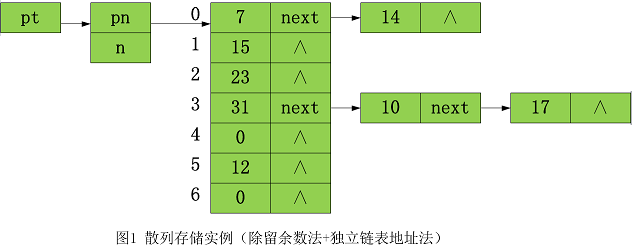本文已收录于专栏
🌲《educoder数据结构与算法_大耳朵宋宋的博客-CSDN博客》🌲
任务描述
本关要求通过补全函数ILH_InsKey和ILH_DelKey来分别实现插入和删除操作。
相关知识
本关讨论散列存储,散列函数使用除留余数法,冲突解决方法采用独立链表地址法。假设有 8 个关键码: 7 , 15 , 23 , 31 , 12 , 14 , 10 , 17 ,采用散列函数hash(key)=key%7,其存储结构图如图 1 所示,它由 7 个独立链表组成,散列值相同的关键码在同一个链表里,独立链表的头结点组成散列表,一共 7 行,编号 0 , 1 , … , 6 。独立链表的每个结点是一个 struct HNode 结构,其定义如下:
struct HNode {int key; //假设关键码为整数HNode* next;};
在散列表中,如果表项的key字段等于 0 (假设有效的关键码值不等于 0 ),则表示该行是一条空链表,例如图 1 中编号为 4 和编号为 6 的行。
散列表的开始地址保存在pn中,散列表的行数为n(图 1 中,n=7),将pn和n组织成结构:
struct LHTable {HNode* pn; //指向散列表,每个表结点是独立链表的表头结点int n; //散列表的长度,一般取(小于等于数据个数的最大)质数};

定义如下操作,各操作函数的功能详见下面给出的代码文件 indLnkHash.cpp 的代码框架:
LHTable* ILH_Create(int n);void ILH_Free(LHTable* pt);bool ILH_InsKey(LHTable* pt, int x);bool ILH_FindKey(LHTable* pt, int x);bool ILH_DelKey(LHTable* pt, int x);void ILH_Print(LHTable *pt);
编程要求
本关的编程任务是补全 step2/indLnkHash.cpp 文件中的ILH_InsKey和ILH_DelKey函数来分别实现插入和删除操作。
- 具体请参见后续测试样例。
本关涉及的代码文件 indLnkHash.cpp 的代码框架如下:
#include <stdio.h>#include <stdlib.h>#include <time.h>#include "indLnkHash.h"LHTable* ILH_Create(int n)//创建散列表, n为表长度,最佳取值:n取小于等于数据个数的最大质数{HNode* pn=(HNode*)malloc(sizeof(HNode)*n);for (int i=0; i<n; i++) {pn[i].key=0;pn[i].next=NULL;}LHTable* pt=(LHTable*)malloc(sizeof(LHTable));pt-> pn=pn;pt->n=n;return pt;}void ILH_Free(LHTable* pt)//释放散列表{if (pt==NULL) return;for (int i=0; i<pt->n; i++) {HNode* curr=pt->pn[i].next;while (curr) {HNode* next=curr->next;free(curr);curr=next;}}free(pt->pn);free(pt);}bool ILH_InsKey(LHTable* pt, int x)//插入关键码x//返回true,表示插入成功//返回false,表示插入失败(关键码已经存在){// 请在此添加代码,补全函数ILH_InsKey/********** Begin *********//********** End **********/}bool ILH_FindKey(LHTable* pt, int x)//查找关键码x//返回true表示找到//返回false表示没找到{int d=x%pt->n;if (pt->pn[d].key==0) {return false;}else if (pt->pn[d].key==x)return true;HNode* curr=pt->pn[d].next;while (curr && curr->key!=x) curr=curr->next;if (curr) return true;else return false;}bool ILH_DelKey(LHTable* pt, int x)//删除关键码//返回true表示该关键码存在,且成功删除//返回false表示该关键码不存在{// 请在此添加代码,补全函数ILH_DelKey/********** Begin *********//********** End **********/}void ILH_Print(LHTable *pt){for (int i=0; i<pt->n; i++) {printf("%5d: ", i);if (pt->pn[i].key) {printf("%d ", pt->pn[i].key);HNode* curr=pt->pn[i].next;while (curr) {printf("-> %d ", curr->key);curr=curr->next;}printf("\n");}elseprintf("-\n");}}
测试说明
本关的测试文件是 step2/Main.cpp ,测试过程如下:
-
平台编译 step2/Main.cpp ,然后链接相关程序库并生成 exe 可执行文件;
-
平台运行该 exe 可执行文件,并以标准输入方式提供测试输入;
-
平台获取该 exe 可执行文件的输出,然后将其与预期输出对比,如果一致则测试通过;否则测试失败。
输入输出格式说明
输入格式: 首先输入一个正整数n,创建一个长n的散列表。 然后输入多个操作:如果输入 “insert” ,则后面跟一个数x,表示将x插入;如果输入 “delete” ,则后面跟一个数x,表示将x删除;如果输入 “end” ,表示输入结束。
输出格式: 输出n个独立链表。
以下是平台对 step2/Main.cpp 的样例测试集:
样例输入: 11 insert 54 insert 77 insert 94 insert 89 insert 14 insert 45 insert 76 insert 23 insert 43 insert 47 end
样例输出: 0: 77 1: 89 -> 45 -> 23 2: - 3: 14 -> 47 4: - 5: - 6: 94 7: - 8: - 9: - 10: 54 -> 76 -> 43
开始你的任务吧,祝你成功
AC_Code
#include <stdio.h>
#include <stdlib.h>
#include <time.h>
#include "indLnkHash.h"
LHTable* ILH_Create(int n)
//创建散列表, n为表长度,最佳取值:n取小于等于数据个数的最大质数
{
HNode* pn=(HNode*)malloc(sizeof(HNode)*n);
for (int i=0; i<n; i++) {
pn[i].key=0;
pn[i].next=NULL;
}
LHTable* pt=(LHTable*)malloc(sizeof(LHTable));
pt-> pn=pn;
pt->n=n;
return pt;
}
void ILH_Free(LHTable* pt)
//释放散列表
{
if (pt==NULL) return;
for (int i=0; i<pt->n; i++) {
HNode* curr=pt->pn[i].next;
while (curr) {
HNode* next=curr->next;
free(curr);
curr=next;
}
}
free(pt->pn);
free(pt);
}
bool ILH_InsKey(LHTable* pt, int x)
//插入关键码x
//返回true,表示插入成功
//返回false,表示插入失败(关键码已经存在)
{
/*请在BEGIN和END之间实现你的代码*/
/*****BEGIN*****/
int d=x%pt->n;
if (pt->pn[d].key==0) {
pt->pn[d].key=x;
return true;
}
else if (pt->pn[d].key==x)
return false;
HNode* prev=&(pt->pn[d]);
HNode* curr=pt->pn[d].next;
while (curr && curr->key!=x) {prev=curr; curr=curr->next;}
if (curr) return false;
HNode* pnode=(HNode*)malloc(sizeof(HNode));
pnode->key=x;
pnode->next=NULL;//pt->pn[d].next;
prev->next=pnode;
return true;
/******END******/
/*请不要修改[BEGIN,END]区域外的代码*/
}
bool ILH_FindKey(LHTable* pt, int x)
//查找关键码x
//返回true表示找到
//返回false表示没找到
{
int d=x%pt->n;
if (pt->pn[d].key==0) {
return false;
}
else if (pt->pn[d].key==x)
return true;
HNode* curr=pt->pn[d].next;
while (curr && curr->key!=x) curr=curr->next;
if (curr) return true;
else return false;
}
bool ILH_DelKey(LHTable* pt, int x)
//删除关键码
//返回true表示该关键码存在,且成功删除
//返回false表示该关键码不存在
{
/*请在BEGIN和END之间实现你的代码*/
/*****BEGIN*****/
int d=x%pt->n;//关键码x的散列值d
if (pt->pn[d].key==0) {
return false;
}
else if (pt->pn[d].key==x) {
if (pt->pn[d].next ==NULL)
pt->pn[d].key=0;
else {
HNode* first=pt->pn[d].next;
pt->pn[d].key=first->key;
pt->pn[d].next=first->next;
free(first);
}
return true;
}
HNode* prev=&(pt->pn[d]);
HNode* curr=pt->pn[d].next;
while (curr && curr->key!=x) {prev=curr; curr=curr->next;}
if (curr==NULL) return false;
prev->next=curr->next;
free(curr);
return true;
/******END******/
/*请不要修改[BEGIN,END]区域外的代码*/
}
void ILH_Print(LHTable *pt)
{
for (int i=0; i<pt->n; i++) {
printf("%5d:", i);
if (pt->pn[i].key) {
printf("%d", pt->pn[i].key);
HNode* curr=pt->pn[i].next;
while (curr) {
printf("->%d", curr->key);
curr=curr->next;
}
printf("\n");
}
else
printf("-\n");
}
}























 1182
1182











 被折叠的 条评论
为什么被折叠?
被折叠的 条评论
为什么被折叠?










